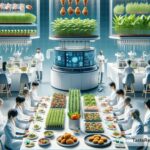The Future of Food: Global Innovation to Feed the World
Food is essential for every human being, yet creating and distributing it to a growing population is becoming more challenging every day. Scientists predict that by 2050, the world will need to feed nearly 10 billion people. With limited farmland, climate change, and environmental issues, many experts are asking: how can we create enough food in a sustainable way? Thankfully, global innovation is stepping in with exciting solutions to shape the future of food.
Challenges in Food Production
Producing food is more difficult than it seems. Farmers depend on healthy soil, clean water, and predictable weather to grow crops. But droughts, floods, and rising temperatures caused by climate change are disrupting traditional farming practices. Additionally, as populations grow, cities expand and farmland shrinks.
At the same time, people are becoming aware of the environmental impact of food. The production of meat, for example, uses a lot of land, water, and energy while generating greenhouse gases. Some scientists say that reducing meat consumption or finding alternatives could make food production more sustainable.
Innovative Solutions for the Future of Food
Scientists, farmers, and food companies around the world are working on new ways to solve these food challenges. Let’s explore some innovations that could change what and how we eat in the future.
1. Vertical Farms
In traditional farming, crops are grown in fields spread over large areas of land. But with less farmland available, scientists are developing vertical farms that grow crops indoors inside tall buildings. Vertical farms use advanced technology, including LED lights and automated watering systems, to grow plants year-round.
The great thing about vertical farming is that crops can grow in small spaces—using less water, no pesticides, and no soil. Cities like Singapore, where farmland is limited, have already adopted vertical farms to grow fresh vegetables closer to where people live.
2. Lab-Grown Meat
You might love a juicy burger, but the process of raising cattle requires immense resources and contributes to climate change. This has led scientists to create lab-grown meat, also known as “cultivated meat.” Instead of raising animals, lab-grown meat is made by collecting cells from an animal and growing them in nutrient-rich conditions.
Lab-grown meat tastes very similar to traditional meat but uses far fewer resources. It could be a sustainable way to provide protein for billions of people without the environmental impact of traditional agriculture.
3. Alternative Proteins
Speaking of protein, more companies are exploring plant-based alternatives to meat. Foods made from soy, peas, mushrooms, insects, or even algae are packed with protein and are much better for the environment. Some people are already enjoying plant-based burgers and nuggets made from these ingredients.
Insects, for example, are eaten in many parts of the world and are starting to gain popularity in the West. They’re high in protein and take much less space, water, and energy to farm compared to livestock.
4. Smart Farming Technology
The future of farming is not just about growing food but doing it efficiently. Innovations in smart farming technology are helping farmers grow more crops with fewer resources. Drones are being used to monitor fields from the sky, while sensors in soil provide real-time data about moisture levels.
Robots and artificial intelligence (AI) systems can plant seeds, remove weeds, and harvest crops more precisely than humans. These technologies improve food production and reduce waste, making farming smarter and more reliable.
5. Food Waste Reduction
Even though we grow enough food to feed the world, much of it never makes it to people’s plates. Food waste happens in farms, factories, restaurants, and homes. Experts say reducing waste is one of the easiest ways to ensure there’s enough food for everyone.
Innovative apps and platforms are connecting consumers and businesses to redistribute surplus food. Technology is helping extend the shelf life of fruits and vegetables through better packaging and storage solutions.
6. Genetic Engineering
Scientists are also using genetic engineering to create crops that are stronger and more resilient. For example, genetically modified (GM) crops can resist pests, grow in extreme weather, and produce higher yields. While GM foods are controversial in some places, they could be essential in feeding populations affected by climate change.
What Will Food Look Like in the Future?
The food we eat in the future could look very different from what we eat today. Imagine walking into a restaurant where dishes are made entirely from plants, lab-grown meat, or insects. Grocery stores might sell fruits and vegetables grown in vertical farms right inside the city. Technology could play a big role in how we access food—from delivery by drones to personalized diets based on our health data.
The change won’t happen overnight, but it’s clear that innovation will continue shaping the way we produce and consume food. A big focus will be on making sure that food production is sustainable, affordable, and able to support everyone on Earth.
Conclusion
The future of food is both exciting and challenging. While we face big problems like climate change and limited resources, scientists are finding creative and innovative solutions to feed the growing population. From vertical farms to lab-grown meat and smart farming technology, the world is working toward a more sustainable food system.
Innovation gives us hope that we can tackle hunger, protect the environment, and ensure food security for generations to come. As individuals, we can also play a part by making smart food choices, reducing waste, and supporting new technologies. Together, we can shape the future of food for a better world.


